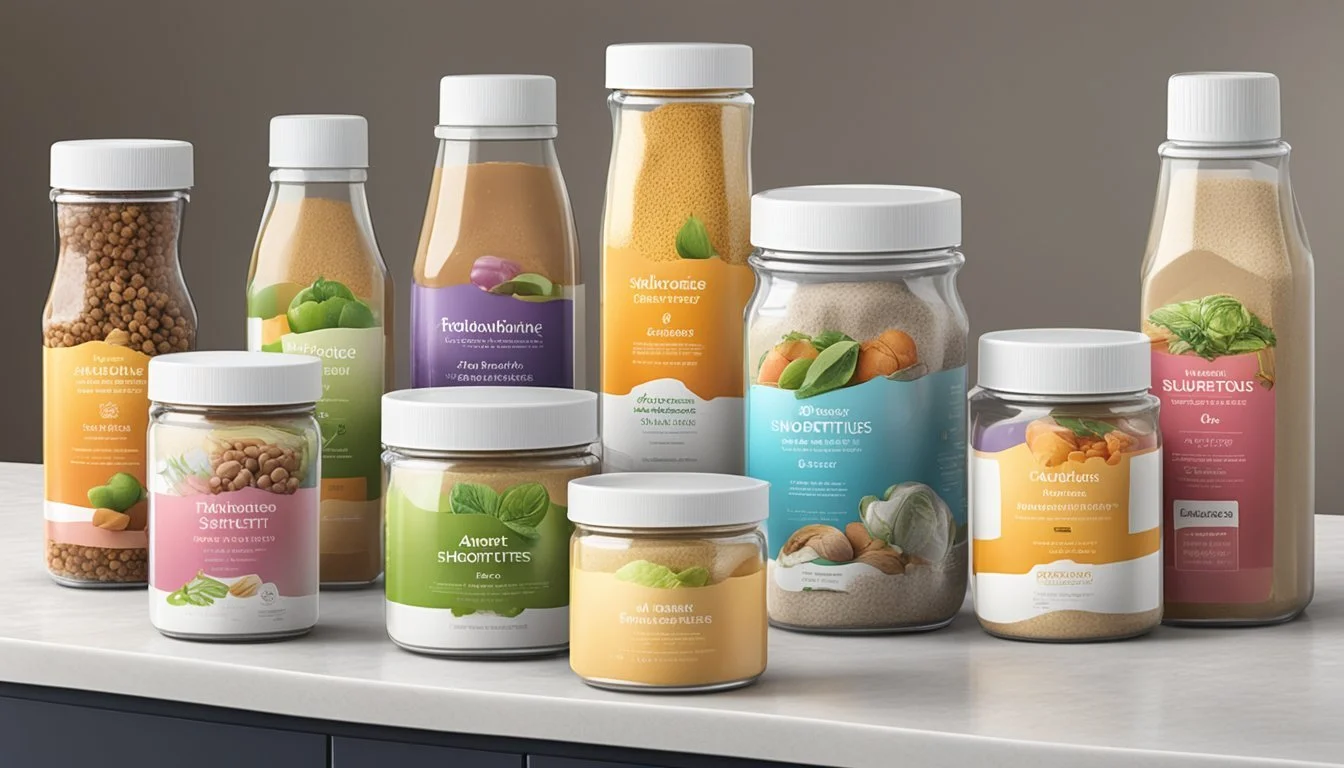Shortening Substitutes
Your Guide to Healthy Baking Alternatives
Shortening, a solid fat traditionally made from hydrogenated vegetable oil, is a staple in baking recipes, especially known for giving pastries and pie crusts their flaky and tender texture. However, with growing health concerns and dietary preferences, bakers might seek shortening substitutes that maintain the quality of their baked goods while aligning with their nutritional requirements or ingredient availability.
Butter is perhaps the most common alternative to shortening and offers a rich flavor and desirable texture in baked products. It can be used in a one-to-one ratio for shortening though it contains a higher percentage of water, which may slightly alter the texture of the final baked good. For those avoiding dairy, coconut oil presents an excellent vegan option with a similar consistency to shortening, although it may impart a mild coconut taste, which can complement certain recipes.
Understanding the properties of various shortening substitutes allows bakers to make informed decisions when modifying their recipes. Vegetable oil, lard, and even margarine can each serve as a substitute and can provide distinctive qualities to a range of baked items. It's important for bakers to consider the flavor profile, texture, and desired outcome of their baking project when selecting a fat substitute, as it can significantly influence the taste and structure of the finished product.
Basics of Fats in Baking
In baking, fats are integral for achieving the desired texture and richness in various baked goods. They contribute to the flakiness in pastries and the tenderness in cakes.
Role of Shortening in Baked Goods
Shortening, which is 100% fat and solid at room temperature, plays a critical role in baking by creating tender, flaky layers, particularly in pastries and pie crusts. With its high melting point, it allows the dough to remain structured without melting too quickly, providing that desired flakiness once baked. Shortening also contributes to the volume and texture of cakes, cookies, and other desserts.
Comparing Fats: Butter, Lard, and Shortening
Fat Type Characteristics Melting Point Fat Content Texture Impact Butter Has water content and milk solids, contributing to a rich flavor. Moderate About 80-85% fat Yields a tender crumb; can be flaky if kept cold and worked properly. Lard Rendered pork fat that is traditionally used for a very flaky texture. Relatively high Near 100% fat Ideal for flaky pie crusts and pastries; less common in cakes. Shortening Vegetable-based, no water content, neutral flavor. High 100% fat Best for achieving uniform texture and maximum tenderness; often used for icings.
Butter, favorited for its rich flavor, contributes both fat and water to a recipe, thus impacting not only tenderness but also the development of gluten, which can result in a less flaky texture if not managed appropriately. Lard is comparable to shortening in its fat content but brings a unique flavor some might find undesirable in sweet baked goods. Shortening is typically preferred when a baker seeks a very tender, neutral-flavored outcome with a consistent texture.
Health Considerations
Choosing the right shortening substitute can affect both the nutritional content and health impact of a recipe. Factors such as saturated fat, trans fats, cholesterol, and potential allergens play a significant role in determining a healthier alternative.
Understanding Saturated and Trans Fats
Saturated Fat: Often found in traditional shortenings and animal-based fats like butter or lard, saturated fats can raise levels of LDL ("bad") cholesterol in the blood, potentially increasing the risk of heart disease. Healthier substitutes typically aim to reduce saturated fat content.
Butter: Contains approximately 80-85% fat, largely saturated.
Ghee: Clarified butter with a similar fat composition but lactose content is reduced, potentially making it a more suitable option for those with dairy sensitivities.
Trans Fats: Artificial trans fats, historically found in some shortenings and margarines, are associated with an elevated risk of heart disease and are largely being phased out of food products.
Margarine: Earlier versions contained trans fats, but many brands now offer trans fat-free options.
Dietary Restrictions and Allergies
Individuals with dietary restrictions or allergies require careful consideration when selecting shortening substitutes:
Dairy Allergies: Purees from fruits like bananas, apples, or prunes provide a non-dairy, lower-fat alternative for vegetable shortening.
Banana Puree: Offers moisture with added nutrients.
Unsweetened Applesauce: Commonly used in muffins for added moisture without excess fat.
Cholesterol Concerns: Plant-based substitutes can be cholesterol-free, beneficial for those monitoring their cholesterol levels.
Healthier Alternatives: Certain oils, like olive or coconut, can be considered for their distinct nutrient profiles. Coconut oil, for example, contains medium-chain triglycerides (MCTs) that are metabolized differently than other fats.
Table 1: Substitutes and Allergen Considerations
Substitute Saturated Fat Trans Fat Dairy-Free Cholesterol-Free Butter High Low No No Ghee High Low Yes No Banana Puree Low None Yes Yes Unsweetened Applesauce Low None Yes Yes Margarine Variable Low/None Yes Yes
When making dietary decisions, it's crucial to consider the specific needs and restrictions of the individual. Nutrition labels and ingredient lists should be read carefully, especially when allergens are a concern. Remember, what constitutes a "healthier" substitute may vary depending on individual health goals and conditions.
Shortening Substitutes Overview
Choosing the right shortening substitute can impact the texture and flavor of the finished dish. Certain substitutes work well in specific types of recipes, so it's important to select them thoughtfully.
Criteria for Substituting Shortening
When selecting a substitute for shortening, one must consider the recipe's desired outcome. A good shortening substitute should mimic the properties of shortening, such as its ability to give structure and tenderness to baked goods. The ratio for substitution and whether the substitute introduces additional flavors are also critical factors. For instance, while butter can be a direct 1:1 substitute, it brings a rich taste distinct from the neutral flavor of shortening.
Solid Fats vs. Liquid Oils
The choice between solid fats and liquid oils can make a significant difference in recipes. Solid fats like butter, margarine, and ghee contribute to a tender crumb in pastries due to their similar melting points to shortening. Here is a comparison of solid and liquid substitutes for shortening:
Substitute Type Consideration Butter Solid Fat Rich flavor, may alter texture Margarine Solid Fat Budget-friendly, similar to butter Coconut Oil Solid Fat Can add coconut flavor Vegetable Oil Liquid Oil Alters texture, makes a softer crumb Applesauce Liquid Reduces fat content, changes moisture
Solid fats are often used in a 1:1 ratio while using liquid oils, such as vegetable oil, may require a different ratio and could result in a different texture, often creating a softer, more moist product.
Substitutes for Shortening in Pie Crusts
In the realm of baking, specifically in the crafting of pie crusts, bakers often seek alternatives to shortening to achieve that desirable flakiness or to adhere to dietary needs. Two well-renowned substitutes are coconut oil and lard, each bringing their own qualities to the dough.
Coconut Oil as a Substitute
Coconut oil serves as a direct substitute for shortening in pie crust recipes. It is known for its firm texture at room temperature and its ability to mimic shortening's role in creating tender pie crusts. When using coconut oil, it should be measured in a solid state and can be replaced at a 1:1 ratio with shortening. Bakers should be aware of the distinct coconut flavor that the oil imparts, which may be noticeable in the finished crust.
Replacement Ratio: 1 cup coconut oil for every 1 cup shortening
Texture Impact: Yields a tender, flaky crust
Flavor Profile: May introduce a subtle coconut taste
Using Lard for Flaky Pie Crust
Lard, a traditional fat used in pie dough, is praised for rendering an exceptionally flaky pie crust. It has a higher melting point than butter, which allows the dough to remain stable during baking, creating layers that puff and separate into the classic flakiness desired in pie crusts. Lard can be used as a one-to-one swap for shortening.
Replacement Ratio: 1 cup lard for every 1 cup shortening
Texture Impact: Delivers superior flakiness in the final crust
Flavor Profile: Offers a neutral taste, though it may vary depending on the source of the lard
Bakers opting for these substitutes in short doughs such as pie crusts will find that coconut oil and lard can both achieve the goal of a flaky, tender product. Each alternative should be chosen based on the flavor profile a baker wishes to impart and whether a plant-based option is preferred.
Vegan and Non-Dairy Alternatives
In vegan baking, one encounters the challenge of replacing traditional shortening, often derived from animal sources. The following subsections provide specific vegan-friendly substitutes that are commonly used in place of traditional shortening.
Margarine and Vegan Butter
Margarine and vegan butter serve as convenient dairy-free alternatives for shortening. They are designed to mimic the taste and texture of butter without any animal-derived ingredients. Margarine is typically made from various vegetable oils and is often fortified with vitamins to match the nutritional profile of butter. On the other hand, vegan butter is crafted to be more similar to butter, with a comparable melting point, which can be especially useful in baking applications where the texture of the final product is crucial.
Example Vegan Butter Ingredients:
Oils (such as soybean, palm, canola)
Water
Salt
Emulsifiers
Natural flavors
Vegetable Shortening and Coconut Oil
Vegetable shortening offers a texture akin to that of traditional shortening, making it ideal for achieving flaky pastries and pie crusts without dairy. It is made from hydrogenated vegetable oil and is solid at room temperature, which helps to create a desirable texture in many baked goods.
Coconut oil is another popular alternative, valued for its natural origin and versatility. It is solid at cooler temperatures and can be used in a 1:1 ratio as a direct substitute for butter or other shortenings. Coconut oil imparts a subtle coconut flavor, which one should consider when incorporating it into recipes.
How to Use Coconut Oil in Baking:
Replace butter or shortening with an equal amount of coconut oil.
If a recipe calls for melted shortening, coconut oil can be used in its liquid form.
Both vegetable shortening and coconut oil offer the richness and texture needed for vegan baking, without compromising the final outcome of dairy-free recipes.
Substitutes for Shortening in Cake and Cookie Recipes
When baking cakes and cookies, choosing the right substitute for shortening can seriously affect the texture and flavor of the final product. Butter and applesauce are two popular alternatives that provide distinctive benefits, whether one seeks richness or is aiming for a low-fat option.
Butter for Richness in Cakes
Butter is renowned for imparting a rich flavor and tender crumb to cake recipes. It is a one-to-one substitute for shortening, meaning if a recipe calls for one cup of shortening, one can use the same amount of butter. Not only does butter contribute a delectable taste, but it also offers a desirable texture, making cakes moist and soft. When using butter in place of shortening:
Ensure that the butter is at room temperature to integrate smoothly with other ingredients.
Consider the salt content: If using salted butter, one might want to decrease any additional salt the recipe calls for.
Applesauce for Low-Fat Cookies
Applesauce serves as an excellent low-fat substitute in cookie recipes and can partially or fully replace shortening. Its natural sweetness and moisture can be particularly effective in soft and chewy cookies. When opting for applesauce:
Use unsweetened applesauce to maintain the recipe’s sugar balance.
Start by substituting half the amount of shortening with applesauce; for example, replace half a cup of shortening with a quarter cup of applesauce.
Adjust the amount based on the desired texture, as applesauce can make the dough more moist.
These substitutions are practical and can help cater to different dietary needs and flavor preferences.
Liquid Oil Substitutes
When substituting shortening with liquid oils in baking, one must consider the flavor profile and health benefits of the oil chosen. The substitution usually works at a one-to-one ratio, but adjustments might be necessary depending on the recipe.
Canola and Olive Oil in Baking
Canola oil, known for its neutral taste and high smoke point, is an excellent one-to-one substitute for shortening in recipes where flavor neutrality is desired. It works especially well in cakes and cookies, maintaining a light texture without altering the taste.
Olive oil, on the other hand, brings a distinct fruity flavor that can complement certain baked goods like savory bread or muffins. When using olive oil, it's best to consider its impact on the flavor profile of the final product. Here's a quick guide:
Quantity of Shortening Amount of Canola Oil Amount of Olive Oil 1 cup 1 cup 1 cup
*Note: For olive oil, adjustments may be desired for taste preference.
Substituting Avocado Oil for Health
Avocado oil is often touted as a healthier alternative due to its monounsaturated fat content. It's a versatile substitution for shortening because of its mild, buttery taste and high smoke point which suits both sweet and savory dishes.
When replacing shortening with avocado oil, use a one-to-one ratio and consider the following:
Avocado oil's liquid state may change the texture of some baked items, potentially resulting in a denser product.
Its health benefits are a plus for those looking to increase their intake of healthier fats.
Health Attribute Avocado Oil Fat Type Predominantly monounsaturated Smoke Point High (suitable for high heat) Flavor Mild and slightly buttery
Using avocado oil as a substitute not only offers a health advantage, but it also can bring a subtly different taste and richness to baked goods.
Special Purpose Fats
Special purpose fats, such as clarified butter and bacon grease, are chosen for their unique cooking properties, such as higher smoke points and the ability to impart a distinctive taste to dishes.
Clarified Butter and Ghee for High-Heat Cooking
Clarified butter and ghee are dairy-based fats that have been processed to remove water and milk solids. This refinement allows for a significantly higher smoke point, making both suitable for high-heat cooking methods like frying. Typically, clarified butter has a smoke point ranging from 450-475°F (232-246°C), while ghee can endure up to 485°F (252°C).
Clarified Butter: Ideal for sautéing and grilling.
Ghee: Often used in Indian cuisine for its nutty flavor and high-heat capabilities.
Bacon Grease for Savory Flavor
When a recipe calls for a fat that delivers a robust, savory flavor, bacon grease is an unparalleled choice. Bacon grease emerges as a byproduct after frying bacon and retains the meat's rich, smoky essence.
Savory Dishes: Bacon grease excels in dishes where a punch of umami is welcome.
Smoke Point: Bacon grease has a moderate smoke point, typically around 325-375°F (163-190°C), making it a good option for medium-heat cooking.
Using these special purpose fats can enhance the flavor profile and texture of culinary creations, each bringing its unique characteristics to the plate.
Practical Tips and Ratios
When substituting for shortening, precise measurement and accurate conversion are integral for maintaining the texture and consistency of your dish. Understanding the shelf life and proper storage of substitutes ensures the longevity and quality of your ingredients.
Measuring and Conversion Tips
For every cup of shortening a recipe calls for, one can use a one-to-one ratio when substituting with these alternatives:
Butter: Provides a rich flavor and flakiness. Use at a 1:1 ratio.
Margarine: A budget-friendly option, also at a 1:1 ratio.
Lard: Matches shortening's texture closely, use at a 1:1 ratio.
Coconut oil: Solid at room temperature, it's a dairy-free choice suitable for vegans, use at a 1:1 ratio.
For a healthier option, applesauce can be used at a half-to-one ratio whereby 1/2 cup of applesauce replaces 1 cup of shortening. Note that applesauce introduces moisture and may not be suitable for all recipes.
Here's a quick reference table:
Substitute Ratio to Shortening Notes Butter 1:1 Adds flavor and flakiness. Margarine 1:1 Budget-friendly. Similar texture. Lard 1:1 Closest texture match. Coconut Oil 1:1 Vegan, may add a coconut taste. Applesauce 1:2 (half-to-one) Adds moisture, use less.
Shelf Life and Storage
Butter and margarine should be stored in the refrigerator where they can last for months, and their expiry dates should be heeded. Lard should also be refrigerated and ideally used within six months of opening. Coconut oil has a longer shelf life and can be stored in a cool, dark place, typically lasting up to two years. When using applesauce, it must be refrigerated and used before its expiration date.
Storage containers should be airtight to prevent contaminants and oxidation. Proper storage not only extends shelf life but also preserves the flavors and textures that these shortening substitutes contribute to recipes.







